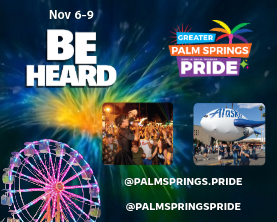Artists working today, from photographers to figurative painters to sculptors, are shattering the conception that love looks a certain way and creating greater visibility for the LGBTQ+ community in the process. Their portrayals of love—not just couples, but gatherings of friends and expressions of self-love and desire—are not only historically important, but they’re also gestures of support for the many young people who will follow in their footsteps.
Hernan Bas
When you walk into a museum, it’s important to be able to see something other than the usual suspects. It’s something that I didn’t have the opportunity to see when I grew up: instances of LGBTQ+ love. We need to have the opportunity just to see different voices in the world.
My work has always been about curiosity. The characters I portray are typically alone, they’re always on the verge of understanding themselves, so it’s more about self-love. I don’t necessarily think of all my characters as being queer necessarily, but they’re involved in a situation that is queer a lot of the time. So, it’s also about sort of celebrating the oddness that exists in the world. When people walk away from my work, I want them to discover something that they didn’t know before. A lot of the stories that I cover are obscure things that haven’t seen the light of day or haven’t been portrayed in painting. So, I want people to be curious and go home and think about it some more and discover that there’s more to life than just the typical conditions that you see in museums and galleries. It’s basically always been about storytelling—if you tell a good story, then hopefully people want to keep reading.
TM Davy
When love’s mysteries are allowed to be naked, and all truths embraced inside a protective sphere of this world, that connective blooming may be the garden of our shared belonging. I believe in art as a democracy of pathways, leading us to and from ourselves.
It is a sadness that the ways of history cut queer love like a weed. Still, I fell in love with painting through those homo electric secrets that dance along our space and time. Gay longing winks to me even from old altarpieces. Such brilliant flowers, hiding under hate, sublimating their genius to the growth of other powers. I am so grateful for all those proud faggots who made their hearts known in unforgiving times. How they fought to stay alive and to keep their dear ones near, so that finally we may be arriving at the promise of our spring: We must trust ourselves to love.
Hilary Harkness
For every person, there’s a different experience with love: seeking it, finding it, losing it, having the courage to start the process all over again. I see my work as part of a larger project of creating representations that reflect the broad spectrum and diverse intricacies of human experience.
In the past, I felt like I was making my paintings for young LGBTQ+ people who were isolated from gay communities or had yet to find theirs; people who were in situations similar to mine when I was growing up, who thought there wasn’t space for their love to be seen or celebrated. Once, a fan drove four hours to hear me give a talk in Florida, my work meant so much to her.
Kyle Dunn
I think back to when I was a kid growing up in the Midwest and didn’t see queer images in art or otherwise. A lot has changed since then! But I feel like it is only just starting to enter the mainstream. If you think of LGBTQ+ movies, the vast majority are coming out stories—which of course serve a purpose to help anyone who isn’t there yet. But what happens after coming out? There is a wealth of stories and experiences about gay life and love that haven’t been told.
Each painting I make has a certain internal climate, so I don’t necessarily have one set goal. And it varies with where I am in my life at the time—there’s always an autobiographical element to some extent. Sexuality and desire are complicated and intersect with a lot of other emotions, and I’m trying to tease out the nuances there.
There is a medieval street feeling to Pride in New York City, which can be great. Even as a proud and out adult, I still subconsciously self-censor in public to some degree. We’re raised to walk a certain way, talk a certain way, feel nervous about PDA. On Pride, there is a loosening of all that that feels very affirming.
Sunil Gupta
It is very important for artists to portray LGBTQ+ love as there is still so little of it visible, even though it may seem that in some small urban bubbles that everything is “cool.” Everything is not cool, as we are emerging from centuries of being defined as unnatural and unclean and we spent most of the last 150 years fighting repressive anti-sodomy laws. A fight that necessarily drew its inspiration from getting sex itself legalized between consenting adults in private, at, I believe, the expense of a more nuanced focus on some notion of love.
Doron Langberg
Love and sexuality in all its forms have been central themes in art from its earliest days. The way we experience the world is mediated by our desires, so I think that no matter what an artist is portraying, they are always also representing who and what they love. So many masters used their desire to convey ideas far beyond love, but because queer love stands out as the exception, whenever it is present in a piece, it’s assumed to only be able to speak about queerness. For that reason, I feel it’s important to represent how my queerness is embedded in my life as directly and honestly as I can, to celebrate all the ways in which we are different and all the ways in which we are the same, and to give queer desire equal gravity and meaning.
Gisela McDaniel
My work focuses primarily on self-love and healing in BIWOC (Black, Indigenous, and Women of Color) and non-binary communities. As a survivor of sexualized violence and an indigenous Chamoru artist in the diaspora, self-love and healing became key to my own survival and the ability to find compassion, respect, and pride in and for myself after trauma. LGBTQ folx have always been an important part of the larger BIPOC community, although their stories have often been suppressed, particularly though not exclusively in Western society. Thanks to artsy.net & NBCnews for their contributions to this piece



